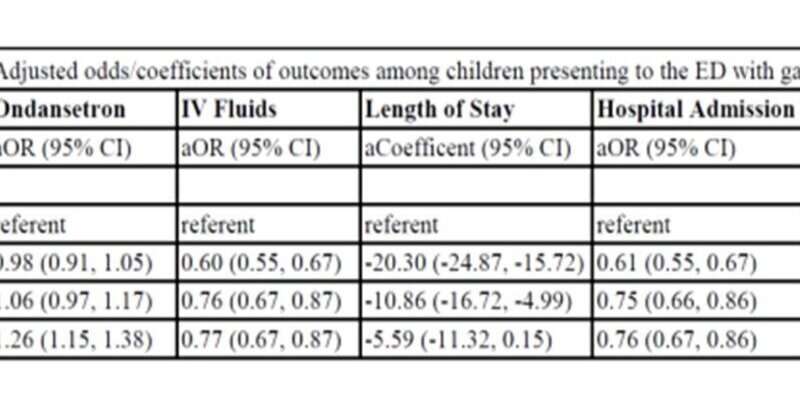Children’s race may play role in treatment for acute gastroenteritis in emergency departments


New research being presented at the American Academy of Pediatrics 2019 National Conference & Exhibition suggests that the treatment children receive in U.S. emergency departments for acute gastroenteritis with dehydration, a common childhood illness, may differ based on their race.
The study abstract, “Impact of patient race/ethnicity on emergency department management of gastroenteritis,” will be presented on Monday, Oct. 28, at the Ernest N. Morial Convention Center in New Orleans.
Acute gastroenteritis is a sudden inflammation of the digestive tract, often caused by a virus, bacteria or other pathogen, with symptoms such as diarrhea, vomiting and fever that can quickly lead to dehydration. The condition accounts for more than 1.7 million outpatient visits and nearly 300 deaths each year among U.S. children.
“Children with acute gastroenteritis sometimes have trouble replacing the fluids and electrolytes their bodies are losing, which makes prompt treatment important,” said abstract author Morgan Congdon, MD, MPH, a pediatric hospitalist at Children’s Hospital of Philadelphia. “However, we found that race and ethnicity may play a role in the type of care and treatment children receive in emergency departments.”
For the study, the research team performed a retrospective analysis of patients aged 6 months to 18 years seen between January 2011 and October 2018 in a large, urban pediatric emergency department for acute gastroenteritis with dehydration.
The researchers evaluated clinical outcomes such as whether the children were given an anti-nausea drug or intravenous fluids, as well as how long the children stayed in the emergency department and whether they were admitted to the hospital.
Of the 30,849 patients seen for acute gastroenteritis with dehydration, 57.2% were non-Hispanic black, 17.9% were non-Hispanic white, 12.5% were Hispanic, and 12.3% were other races. Adjusting for age, gender, language, insurance, and how sick a child was at presentation using triage acuity rating, researchers found that non-Hispanic black, Hispanic, and other race patients were significantly less likely to receive intravenous fluids and be admitted to the hospital than white patients. Non-Hispanic black and Hispanic patients also had shorter emergency department length of stay. Other race patients were more likely to receive the anti-nausea drug ondansetron than non-Hispanic white patients, but no significant differences were observed for non-Hispanic back and Hispanic patients.
The researchers said there were no significant racial/ethnic differences in 72-hour revisits to the emergency department, however, which may suggest possible discretionary overtreatment in white patients as opposed to undertreatment in non-white patients.
“This study is important because it highlights a growing body of evidence that children do not always receive equal health care in the emergency department based on the child’s race or ethnicity,” Dr. Congdon said. She said further research is needed to understand the drivers of these racial and ethnic differences and develop ways to address them.
Source: Read Full Article




